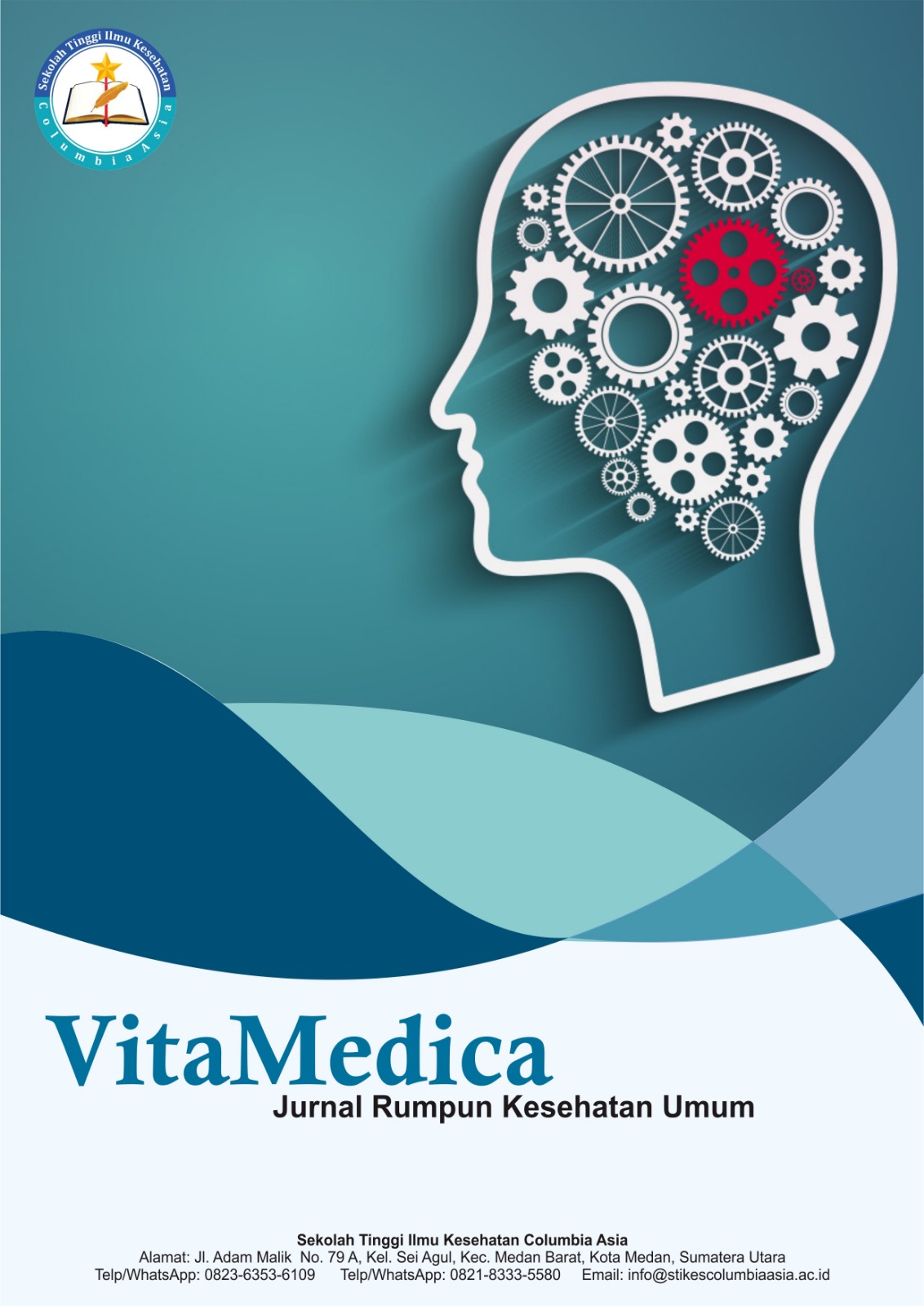Faktor-Faktor yang Berhubungan dengan Kejadian Baby Blues Syndrome pada Ibu Postpartum di Wilayah Kerja Puskesmas Teling Manado
DOI:
https://doi.org/10.62027/vitamedica.v3i2.375Keywords:
Postpartum Mother, Age, Parity, Baby blues syndromeAbstract
Baby blues syndrome occurs in mothers after giving birth, which has an impact on both the mother and the baby. Many factors cause baby blues such as lack of mental preparation to become a mother due to young age and inexperience, the number of children a mother has causes susceptibility to suffer from baby blues. The purpose of this research was to find out the factors related to the occurrence of baby blues syndrome at the Teling Community Health Center Of Manado. This type of research is observational analytic with a cross-sectional approach. The sampling technique used simple random sampling with a total of 59 respondents. Data were collected using the Edinburgh Postpartum Depression Scale (EPDS) questionnaire. The collected data were processed with the help of the SPSS computer program, data analysis with the Chi Square Test with a significance level of α 0.05. The results of the study showed that there was a correlation between age and Blues Syndrome at the Teling Community Health Center (P value 0.000 < α 0.05). There was a correlation between parity and Blues Syndrome at the Teling Manado Community Health Center (P value 0.008 < α 0.05). The conclusion of this study is that there is a correlation between age and parity with Blues Syndrome at the Teling Health Center. It is suggested to nurses as caregivers to not only meet physical needs but also psychological needs, especially identifying abnormal deviations as early as possible and collaborating with other health teams in meeting emotional needs through providing counseling, bonding attachment between mothers and their babies during the postpartum period so that mothers get good health and healthy babies.
References
Almida, E. N., Dahlia, Y., Ronanarasafa, & Shammakh, A. A. (2023). Hubungan Usia dan Paritas Terhadap Kejadian Baby Blues Syndrome Pada Ibu Postpartum di Kecamatan Sambelia, Lombok Timur. Nusantara Hasana Journal, Volume 2 No 11, Hal. 30-36. https://doi.org/DOI: https://doi.org/10.59003/nhj.v2i11.821.
Aprilianti, C., Prabasari, S. N., Suganda, Y., Kuntoadi, G. B., Prasetyowati, T. A., Solama, W., Kartikasari, M. N. D., Winarni, Fitriani, A. L., Noya, F., & Sari, D. (2023). Penyulit dan Komplikasi Masa Nifas. Get Press indonesia. Kota Padang
Ariesca, R., Helina, S., & Vitriani, O. (2018). Faktor-Faktor Yang Berhubungan Dengan Kejadian Postpartum Blues di Klinik Pratama Wilayah Kerja Puskesmas Payung Sekaki Kota Pekanbaru. Jurnal Proteksi Kesehatan, Vol.8 No 1, 15–23. https://doi.org/DOI: https://doi.org/10.36929/jpk.v7i1.125.
Aryani, R., Afriana, & Faranita. (2022). Faktor-Faktor yang Berhubungan dengan Baby Blues Syndrome Pada Ibu Post Partum di RSUD dr. Zainoel Abidin Kota Banda Aceh. Journal of Healtcare Technology and Medicine, 1325–1336. https://doi.org/DOI: https://doi.org/10.33143/jhtm.v8i2.2401.
BKKBN. (2017). Usia Perkawinan. Badan Kependudukan dan Keluarga Berencana Nasional. https://www.bkkbn.go.id/detailpost.
Efi, F., Nainggolan, A., W., Purba, E. M., & Manurung, H., R. (2024). Faktor-Faktor Yang Mempengaruhi Terjadinya Baby Blues Pada Ibu Postpartum di Puskesmas Idi Rayeuk Kabupaten Aceh Timur Tahun 2023. Jurnal Ilmiah Multi Disiplin (JIMU), Vol. 02, No. 03, Tahun 2024, Hal. 757-765. https://doi.org/DOI: https://doi.org/10.70294/jimu.v2i03.456.
Karjatin, A. (2016). Modul Bahan Ajar Cetak,Keperawatan Maternitas. Kementerian Kesehatan Republik Indonesia, Pusat Pendidikan Sumber daya Manusia Kesehatan. Badan Pengembangan dan Pemberdayaan Sumber daya Manusia Kesehatan. Kementerian Kesehatan. Jakarta
Kumalasari, I., & Hendawati. (2019). Faktor Risiko Kejadian Postpartum Blues Di Kota Palembang. Jurnal Kesehatan Poltekkes Palembang., Volume 14. No.2 Desember 2019.https://jurnal.poltekkespalembang.ac.id/index.php/JPP/article/view/408.
Kurniawaty, M. (2019). Post Partum Depresion pada Ibu Ditinjau dari Cara Melahirkan dan Faktor Demografi. [Universitas Negeri Semarang]. http://lib.unnes.ac.id/33627/
Mardhatillah, D., Gandini., A.L.A., Ratnawati. (2019). Faktor-faktor yang Berhubungan dengan Kejadian Postpartum Blues di Wilayah Kerja Puskesmas Temindung Tahun 2019. https://repository.poltekkes-kaltim.ac.id/229/1/
Massa, K., Ratiyun, R. S., Sari, N. A. M. E., Yanti, N. Luh. G. P., Budiarti, A., Aniarti, R. P., Juwita, R., Suryati, Suryanigsih, M., Astuti, Y., Wulandari, M. R. S., Qurrotu Anini, Farida, & Ulfa, M. (2023). Buku Ajar Keperawatan Maternitas. PT.Sonpedia Publishing Indonesia. https://books.google.co.id/books/about/BUKU_AJAR_KEPERAWATAN_MATERNITAS.html?id=MHLVEAAAQBAJ&redir_esc=y
Nasir, A., Muhith, A., & Ideputri, M. E. (2011). Buku Ajar Metodologi Penelitian Kesehatan. Nuha Medika. Yogyakarta
Notoatmodjo, S. (2018). Metodologi penelitian Kesehatan. Rineke Cipta. Jakarta
Permatasari, N. R., Hawaidah, & Madya, F. (2024). Faktor Yang Mempengaruhi Kejadian Baby Blues Syndrome. Https://Journal.Universitaspahlawan.Ac.Id/Index.Php/Prepotif/Article/View/25215, Volume 8 No 1, Hal. 244-253. https://doi.org/DOI: https://doi.org/10.31004/prepotif.v8i1.25215.
Pratiwi, K., & Rusinani, D. (2020). Buku Ajar Psikologi Perkembangan Dalam Siklus Hidup Wanita. Deepublish Publisher. ttps://www.google.co.id/books/edition/Buku_Ajar_Psikologi_Perkembangan_Dalam_S/zZoCEAAAQBAJ?hl=id&gbpv=1&dq=buku+baby+blues+syndrome&pg=PT161&printsec=frontcover.
Saraswati, D. E. (2018). Faktor Yang Berpengaruh Terhadap Kejadian Postpartum Blues di desa Campurejo dan Sukorejo Kecamatan Bojonegoro. Jounal of Health Science, Vol.11 No.2, Hal..130-139. https://journal2.unusa.ac.id/index.php/JHS/article/view/105.
Sari, R. P., Densy, A., & Keraman, B. (2020). Analisis Faktor Risiko Kejadian Postpartum Blues di Puskesmas Perumnas Kabupaten Rejang Lebong. Jurnal of Midwifery, Vol. 8. No.1 April 2020. https://jurnal.unived.ac.id/index.php/JM/article/view/1031.
Susila, & Suyanto. (2015). Metodologi Penelitian Cross Sectional. BOSS SCRIPT. Klaten.
Ulfa, P., Agustina, & Mainidar. (2024). Analisis Faktor Yang Mempengaruhi Terjadinya Baby Blues Sydrome Pada Ibu Nifas di Wilayah Kerja Puskesmas Darul Imarah. Jurnal Protif Preventif, Volume 7. No4, Hal 806-813. https://doi.org/DOI: https://doi.org/10.47650/jpp.v7i4.1412
Wakhidah, N. (2024). Faktor Yang Mempengaruhi Postpartum Blues di RS PKU Muhanmmadiyah Patanahan [Muhammadiyah Gombong]. https://repository.unimugo.ac.id/3206/
Widjaja, I. P. (2014). Postpartum Blues. SMF Obstetri dan Ginekologi. Universitas Udayana Denpasar. Bali
Wulan, N., Mawati, I. P., & Sutandi, A. (2023). Analisis Faktor Yang Berhubungan Dengan Kejadian Baby Blues Syndrome pada Ib Postpartum. Journal OF Nursing Practice And Education, Vol.4 No.1, Hal. 194-201. https://doi.org/DOI : 10.34305/jnpe.v4i1.952.
Yuhaeni, N., & Indawati, E. (2024). Analisis Faktor Yang Berhubungan Dengan Kejadian Baby Blues Syndrome Pada Ibu NIfas di Klinik Cempak Medical Centr Tambun Bekasi Tahun 2023. Malahayaty Nursing Journal, Volume 6 Nomor 4 Tahun 2024, Hal. 1351-1372. https://doi.org/DOI: https://doi.org/10.33024/mnj.v6i4.11139.
Downloads
Published
How to Cite
Issue
Section
License
Copyright (c) 2025 VitaMedica : Jurnal Rumpun Kesehatan Umum

This work is licensed under a Creative Commons Attribution-ShareAlike 4.0 International License.







